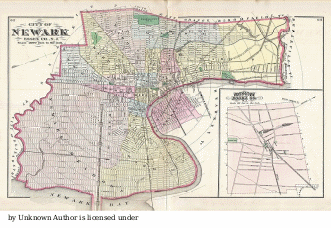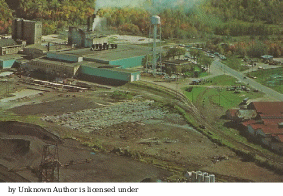Introduction
Newark city is located in Essex County and consists of an average of 35% of the population of the county. Additionally, Newark is the largest city in the state of New Jersey concerning its population (3.1% of the total New Jersey population). There is a larger number of females (51% of the total population) compared to males (49% of the total population); these statistics also apply to the whole state of New Jersey. The population in Newark consists of a younger nation in comparison to the Country or state. Also, a huge portion of the Newark population consists of ethnic minority groups (89%). However, the population of African Americans and the younger nation has been reducing over the past few years. A good percentage of the population aged five years and above speak English at home, although there is a small percentage that speaks Spanish and other languages at home. Moreover, Newark comprises nine ZIP code areas that vary in their economic and demographic characteristics. For an effective survey, it is crucial to consider all the ZIP codes in the city.

Physical Hazard
Poor Health Care Facilities
Many residents in Newark city lack health care insurance and it is a huge barrier to access proper health care services. Residents usually counted on charity care or Medicaid to cover their health needs, which may not cover all the required services. To avoid hustles in healthcare facilities, most residents usually ignored their health problems till they intensify and require urgent conditions. However, the enactment of the Affordable Care Act (ACA) brought some hope to adults in the age bracket of 18-64 who were not insured. However, Newark is still experiencing shortages of primary healthcare workers. Also, several facilities do not accept Medicaid which inconveniences people who benefited from the ACA medical expansion.
Chemical Hazard
Dumping and Improper Chemical Storage
White Chemical Company (former manufacturer of compounds retardant to flames and acid chlorides) is located in Newark covering a land of about 4 acres. The company is also surrounded by a dense population of Newark city and near the water supplies. Additionally, there is also a sportswear manufacturer on the west side of White Chemical Company (NJ health department, 1994). The Newark fire department noted ruptures, leaks, and uncovered drums back in May and April of the year 1990 as one of the inspectors developed a serious cough, irritation of the eyes, and sore throats after some visits to the site.
Owing to this discovery the NJDEPE (New Jersey Department of Environment Protection and Energy) took matters into their own hands and uncovered several vats, cylinders, tanks, and storage rooms in the laboratories. Some of the chemicals stored in the site include oxidizers, corrosives, flammable liquids, organic acids, acid chlorides, and shock-sensitive materials. The storage of these chemicals was done very recklessly ignoring factors like weathering. After a short while, it was concluded that the site of the White Chemical company was an imminent danger to the health of its workers and the large population surrounding the company (NJ health department, 1994). Hence, it was suggested that the site should be stabilized and secured, set effective plans on ways of protecting the residents and the workers, and have the air from the site heavily monitored to control atmospheric infections.

Currently, the White Chemical company site was fenced off and highlighted with warning signs. Also, the drums were removed, characterization of the site conducted, staging performed, and lab packs completed. The site no longer poses an imminent threat to the residents’ health. Nevertheless, a huge mass of equipment was left on-site after the lockdown and it may still have chemical residual value. Additionally, reports of increased vandalism and trespassing on the site have been on the rise. Previously reports only focused on imminent threats to the health of workers and residents, however, after a long-time exposure of workers to the chemicals there is a possibility of offsite contaminations especially leaks to water surfaces and other properties. The most dangerous exposure method however is the atmospheric releases.
Health Status
The health status of Newark residents is in a critical position. The average age for death for non-Hispanic Whites is 72.2 years, 61 years for Hispanics, and 64 years for Black Americans. The following are major diseases that affect the Newark population as a result of the physical and chemical hazards listed above.
Cancer
The cases of cancer in Newark and New Jersey are way higher compared to the U.S rates, though pacific islanders and Asians are not heavily affected. According to City of Newark Community Assessment, the diagnosis of lung, colorectal, and prostate cancer in white men is higher than that of black men (2017). The statistics also show black women have earlier detections for breast cancer compared to white women. In comparison to either Hispanics or whites (16%), cancer has taken the lives of more Blacks (65%).
Diabetes
According to the City of Newark Community Assessment, there are over 150,000 residents who are living with diabetes knowingly, while a huge 60,000 residents have diabetes but are not aware (2017). The disease is not evenly shared in the population as some researches show that ethnic minorities like Hispanics, Blacks, and Asians are more likely to be living with diabetes compared to Whites. Additionally, due to the rise of the older population in Newark, there was an inevitable increase in diabetes cases. In 2012 alone, 77 Blacks, non-Hispanic and Hispanics died from diabetes in Newark city.
Heart Diseases
In 2009, heart disease was the leading cause of death especially in females in the state of New Jersey claiming 9,444 female lives. Just like the other diseases, heart disease affects one ethnic minority more compared to the others. The mortality rates of Black people from strokes and cardiovascular diseases in Newark city are very high. Between 2009-2011, out of the 263 people who suffered from a stroke, 30% were Hispanics and Whites (equally) while 4% were the non-Hispanics, and 66% were Black.
Child and Infant Health
When proper prenatal care is given to pregnant women on time, pregnancy complications become easy to identify and control. Additionally, proper prenatal care involves educating patients and managing health conditions resulting from pregnancies. According to the City of Newark Community Assessment, mortality rate of infants in 2003 was at 11.5%. Compared to the state (New Jersey) and nation, Newark women received lower prenatal care (2017). In 2007, research showed that Newark was not receiving prenatal care completely. Luckily, the next year the whole state was awarded grants by a Task Force which increased access to prenatal care. Nonetheless, there is still an ongoing struggle to provide women with proper prenatal care and Newark seems to be the only city that is still not improving this sector.
Moreover, there is also a high case of early teenage pregnancies in Newark city. The poor state of healthcare services and especially prenatal care could be the main cause of the high mortality rate of infants (11.5%) compared to both the state and nationwide. Again, the Black community is most affected, the infant mortality rate is 12.3% for every 1000 children while that for Hispanics is 4.9% for every 1000 children.
Why the African American community is mostly affected
Many African Americans living in Newark complain of lacking means of paying for health services yet there are programs such as the ACA which were designed to assist all Americans who found it difficult to pay for their insurance. Younger African Americans are dying of conditions usually found in older White Americans. There is a disparity in the general healthcare system which is gradually increasing the mortality rate of African Americans. Additionally, the rate of employment in Newark and the African American community is very low which directly affects the quality of healthcare these residents are accustomed to.
Solutions
Many health issues are affecting Newark city and especially the African American community. Some of the best approaches to these problems include:
- Conducting strict follow-ups on community partnerships. Though Newark is experiencing many health concerns with its residence, the city has many resources at its disposal. For instance, there are three acute hospitals in Newark offering outpatient and inpatient services which also include family packages.
- Improving the community-based healthcare centers would be a great way to improve equality as these clinics serve the Hispanic and African American communities. Also, the state should look at improving the health services at learning facilities.
- Private Insurance. The state should also ensure that all employers provide their employees with insurance that stretches to their families. These efforts would go a long way in ensuring the number of uninsured people in Newark city reduces gradually.
- Medicaid. Medicaid is health insurance founded from the ACA program that is aimed at low-income families and individuals. People who get Temporary Assistance to Needy Families (TANF) or SSI also receive Medicaid. Expanding the funding of the ACA would help many more families and needy individuals. Additionally, the state should work to ensure the Medicaid is acceptable to all health facilities to ensure standard availability of medical services.
- Health drives. As stated earlier many residents of Newark do not know the health conditions they are suffering from diabetes and other lifestyle diseases. Conducting health drives in the area is a great way of creating awareness about the various health concerns and their symptoms.
- Conducting more surveys to analyze physical and chemical hazards that may develop in the coming years.
References
City of Newark, NJ (2017). Community Health Assessment. Health affairs, 2-5(7), pg. 15-55. Web.
The New Jersey Department of Health (1994). White Chemical Corporation Newark, Essex County, New Jersey Cerclis NO. NJD001239185. White Chemical Company, pg.6-14.